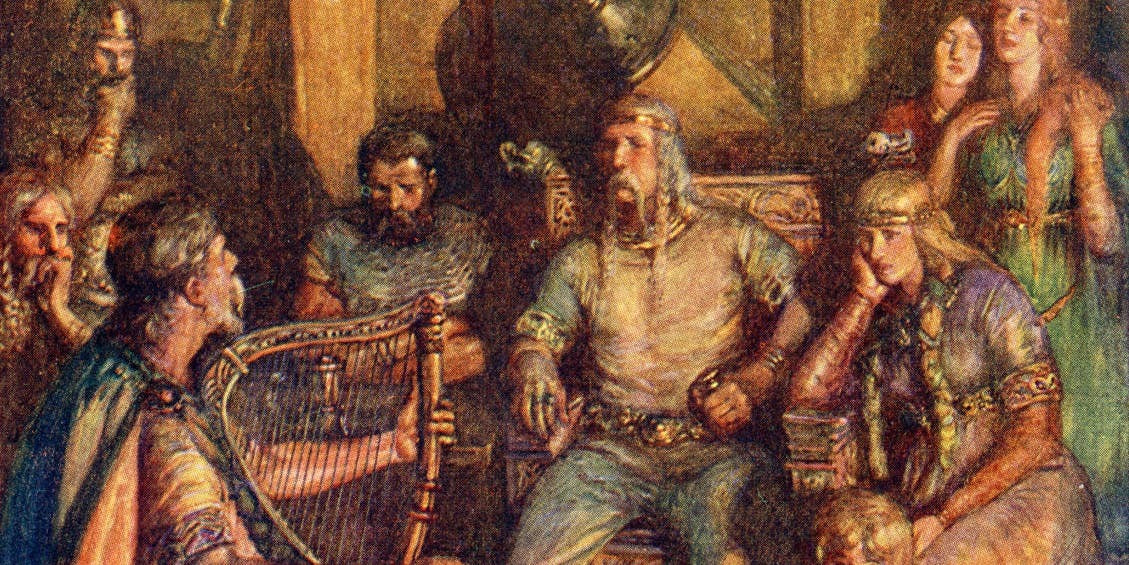Article: The Elaborate History Of Viking Arm Rings - Their Uses for Oaths, Trading & Style
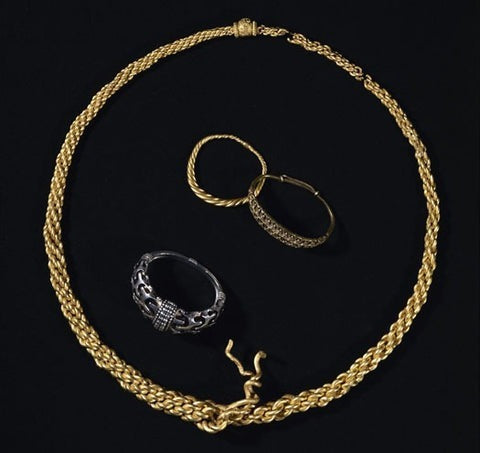
The Elaborate History Of Viking Arm Rings - Their Uses for Oaths, Trading & Style
Viking history is adorned with tales of valor, wealth, and honor, and at the heart of this narrative are the iconic Viking arm rings. Beyond being mere accessories, these arm rings were symbolic vessels of oaths, a currency of their time, and statements of personal style. In this exploration, we dive into the rich tapestry of Viking culture, unraveling the significance of these arm rings in oaths, trading, and the distinctive Viking aesthetic.

Ormeitr - Serpent Dragon Viking Bangle Oath Ring
The Allure of Viking Adornments:
Viking jewelry transcended mere aesthetics; it became a potent reflection of an individual's status and wealth within Old Norse society. Among these emblematic pieces, arm rings, meticulously crafted from precious metals such as silver and gold, stood out as tangible markers of a Viking's prosperity.

The Viking hoard from Vester Vedsted containing both gold & silver arm rings (National Museum of Denmark).
In the Viking Age, the act of having one's riches smelted into an arm ring was not merely a fashion choice; it was a deliberate assertion of wealth and social standing. These rings, often intricately designed, were symbols of affluence that transcended their metallic composition. The more arm rings a Viking adorned, the more pronounced their status in society, creating a direct correlation between the number of rings and the formidable impression one left on their peers.
For Vikings, the choice to wear multiple arm rings wasn't just a matter of fashion; it was a strategic decision to visually communicate their financial prowess. Each ring represented a tangible investment, a piece of their wealth forged into a wearable treasure. The adornment of arm rings became a display of not only personal taste but also a visible proclamation of one's success in amassing precious resources.
In a society where ostentation and material wealth held significant value, arm rings emerged as more than mere accessories. They became a language, conveying messages of social standing, prosperity, and influence. The significance of these rings extended beyond their ornamental appeal, weaving a narrative of success and achievement for the Viking adorned with their shimmering, precious arm rings.
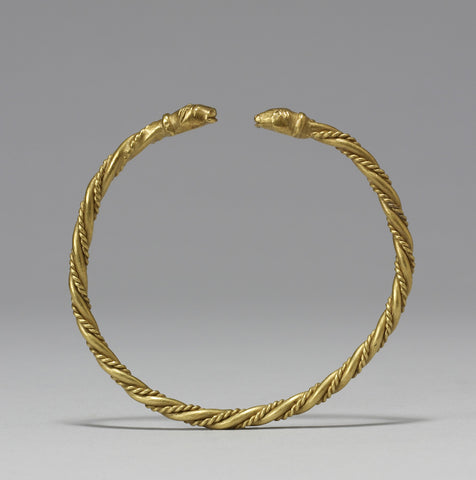
Trading in Viking Times - Arm Rings as Currency:
In a world devoid of modern currencies, Vikings ingeniously adopted arm rings as one of their distinctive economic solutions. Picture a bustling Viking market, where the jingle of coins was replaced by the clink of arm rings – wearable symbols of wealth and prestige. Crafted from silver, these rings transcended mere adornments; they were transformed into a practical and convenient form of currency.

Viking hoard discovered across Western Zealand, Western Jutland and the Island of Faslter (National Museum of Denmark)
Unlike cumbersome coinage or the need for pouches to carry precious metals, Vikings embraced the elegance of arm rings. These sturdy bands, worn snugly around wrists and arms, allowed for the effortless flaunting and protection of their wealth. The silver arm ring, a compact embodiment of prosperity, became a portable treasure that eliminated the need for bulky currency storage.
The ingenious aspect of this Viking economic model lay in the adaptability of arm rings. Breaking these rings into smaller, standardized units known as 'hacksilver' enabled seamless transactions. Merchants and traders, adorned with their arm rings, engaged in a system where the rings themselves were both the currency and the measure of wealth.

Geri & Freki Bangle Torc - Viking Wolf Arm Ring
The convenience was unparalleled – no need for complicated exchanges or intricate calculations. The value of an arm ring was not just in its precious metal but in its utility. The more hacksilver one possessed, the more esteemed their wealth, creating a visual representation of affluence that resonated in every transaction.
Viking markets, buzzing with the vibrant energy of trade, bore witness to this unconventional yet highly effective currency system. Arm rings, with their dual role as jewelry and currency, epitomized the pragmatic and stylish approach Vikings took toward both wealth and commerce. Each transaction was a tangible celebration of prosperity, the clasp of an arm ring signaling not just a purchase but a visible acknowledgment of financial prowess in the Viking world.
Viking Arm Rings, Also Known as 'Oath Rings' - Sacred Bonds of Honor:
In the intricate tapestry of Viking culture, oaths stood as sacred pillars, binding individuals in solemn contracts of honor. Central to this system were arm rings, symbolic treasures that played a pivotal role in the solemn act of swearing an oath. As Vikings held oaths in high regard, the arm ring became more than a piece of jewelry; it transformed into a visible reminder of a sworn promise, a sacred bond that carried weighty consequences if ever broken.
The Norse god Ullr, often associated with oaths, stands as a testament to the cultural significance of swearing promises in Viking society. In the poetic verses of the Eddas, there are profound mentions of oaths sworn on arm rings, weaving a narrative that ties the divine and the mortal in the act of making commitments. 'Ullr's ring' emerges as a potent symbol, reflecting the divine approval sought in the binding of oaths.
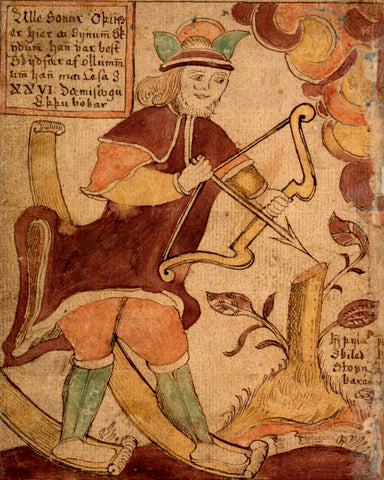
Image depicting Ullr, the God of Oaths, on skis and wielding a bow, as seen in an 18th-century Icelandic manuscript.
Quoting from the Eddic Poems, we find instances where arm rings become the focal point of oath-taking. In the Eyrbyggia Saga, a ring displayed on a stall serves as a platform for all men to swear their oaths. The solemnity of such occasions is further echoed in the Anglo-Saxon Chronicle, where a massive Danish army swears an oath on a "sacred ring" during a peace agreement with King Alfred. These instances illuminate the diverse contexts in which arm rings became the tangible vessels of binding oaths, whether in the communal setting of a Viking hall or on the battlefield.
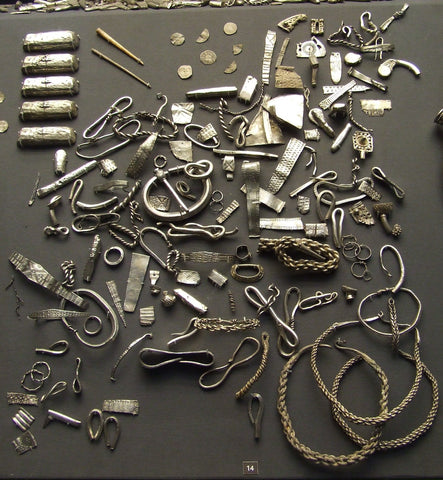
A Viking Hoard, Including Arm Rings, Displayed in the British Museum
For Vikings, an oath sworn on an arm ring was not a casual commitment but a profound undertaking, a pact that resonated with divine approval. The arm ring, worn visibly on the warrior's arm, served as an outward symbol of internal dedication. Once pledged, the ring became inseparable from the wearer, a constant reminder of the oath's weight and the honor associated with keeping one's word.
In the intricate dance of Norse mythology and mortal existence, arm rings transcended their material form. They became conduits of honor, connecting individuals to the divine, weaving promises into the very fabric of Viking culture. To break such an oath, symbolized by the arm ring, was to invite severe consequences, for the Vikings understood that the bonds forged through these sacred treasures were not to be taken lightly.
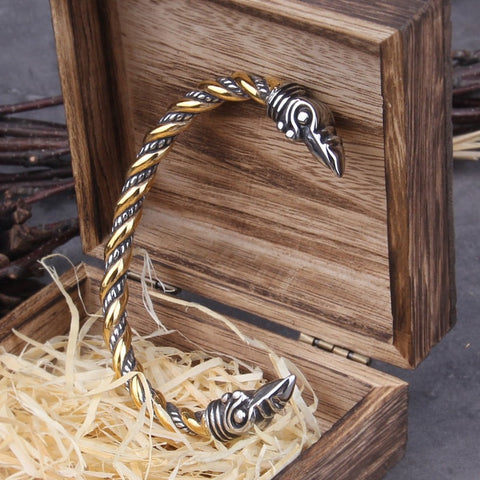
Hrafnheimr - Viking Raven Oath Ring
How Were Arm Rings Made?
Arm rings emerged as masterpieces of both function and form when it came to Viking craftmanship. These tangible symbols of wealth and status showcased the ingenuity and artistry of Norse craftsmen. Viking arm rings, varying in designs from simple and utilitarian to intricately decorated, formed a diverse array that not only served practical purposes but also adorned the wearers as expressions of wearable art.
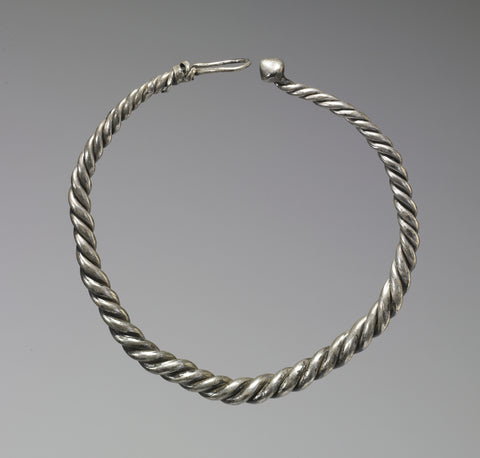
The creation of Viking arm rings was a meticulous process, with craftsmen employing their skills to fashion these treasures from precious metals, most notably silver. The rings were not mere accessories; they were a fusion of craftsmanship and symbolism. While some were crafted for everyday wear, designed with simplicity and functionality in mind, others were elevated to the status of intricate artworks, reflecting the wearer's personal taste and social standing.
The crafting process involved shaping the metal into a band that could snugly fit the upper arm. The choice of materials, including silver, added a touch of opulence to these adornments. The Norse craftsmen, known for their metalworking prowess, often adorned arm rings with intricate patterns, engravings, or other embellishments that turned each piece into a unique creation.

The variety in Viking arm ring designs was not just about aesthetics; it also conveyed information about the wearer. The simplicity of some rings hinted at practicality, making them suitable for everyday use. On the other hand, more elaborate and finely detailed arm rings were reserved for special occasions, showcasing the wearer's elevated social status and wealth. These rings became a form of silent communication, allowing Vikings to express their individuality and societal standing without uttering a word.
Some arm rings were adorned with symbols and motifs inspired by Norse mythology, paying homage to gods, creatures, or epic tales. Others featured intricate patterns that showcased the artisan's skill. The wearers of these rings carried not just a piece of jewelry but a narrative—a personal and cultural story etched in metal.
Viking Arm Rings in the Modern Day: A Timeless Connection
In the vast tapestry of time, Viking arm rings have transcended their historical roots to become timeless artifacts that continue to captivate modern audiences. Whether worn for their historical significance, as bold fashion statements, or even as symbols of commitment, these pieces evoke a profound sense of connection to the mighty Vikings.
Fast forward to the present day, and Viking arm rings have found a place in the hearts and wardrobes of enthusiasts and fashion-forward individuals alike. Beyond being mere accessories, these rings carry with them the weight of a rich cultural legacy. For some, wearing a Viking arm ring is a deliberate homage to the indomitable spirit of Norse seafarers and explorers. It is a way of carrying a piece of history into the contemporary world, a tangible link to the past that adds a touch of mystique to personal style.

Drekieitr - Serpent Dragon Head Viking Arm Ring
Discover Our Viking Arm Rings: A Blend of Tradition and Style
As you embark on a journey into the fascinating world of Viking arm rings, why not seize the opportunity to embrace a piece of this rich heritage for yourself? Our shop proudly offers a curated collection inspired by the craftsmanship and symbolism of authentic Viking arm rings. Each piece is more than a mere accessory; it is a nod to history, a fusion of tradition and contemporary style.
In our collection, you'll find a diverse array of Viking arm rings, each meticulously crafted to capture the essence of the originals. Whether you're drawn to the simplicity of everyday wear or the intricate designs reserved for special occasions, our selection caters to every taste and style.
Explore our curated collection today and let the spirit of the Vikings become an integral part of your journey. Whether you're seeking a connection to ancient traditions, making a bold fashion statement, or expressing a commitment to a cause, our Viking arm rings are more than adornments—they are symbols of a legacy that spans centuries. Choose a piece that resonates with your spirit and wear it with pride as you carry a piece of Viking history into the modern day.
References:
Denmark Museum 'The mysterious oath rings' [https://en.natmus.dk/historical-knowledge/denmark/prehistoric-period-until-1050-ad/the-bronze-age/arm-rings-of-gold/the-mysterious-oath-rings/]
Jennifer M, 'Viking Oath Rings: Arm Bracelets and Oath Taking in Viking Culture' [https://norseauthority.com/2022/12/28/viking-oath-rings/]
National Museum of Ireland 'Viking silver arm-rings discovered on the shores of Clew Bay, Co. Mayo' [https://www.museum.ie/en-IE/Collections-Research/Folklife-Collections/Folklife-Collections-List-(1)/Other/Vikings-in-the-west-of-Ireland/Viking-silver-arm-rings-discovered-on-the-shores-o]
Scottish History and Archaeology 'How ‘Viking’ is the Galloway Hoard?' [https://www.nms.ac.uk/explore-our-collections/stories/scottish-history-and-archaeology/galloway-hoard/sections/how-viking-is-the-galloway-hoard/]
The British Museum 1849 [https://www.britishmuseum.org/collection/object/H_1849-0210-1]
The British Museum, BBC 'Viking Gold Arm Ring' [https://www.bbc.co.uk/ahistoryoftheworld/objects/K1RjEK2NRYGHP55guENL6w]
Wikipedia 2024 'Arm Rings' [https://en.wikipedia.org/wiki/Arm_ring]
